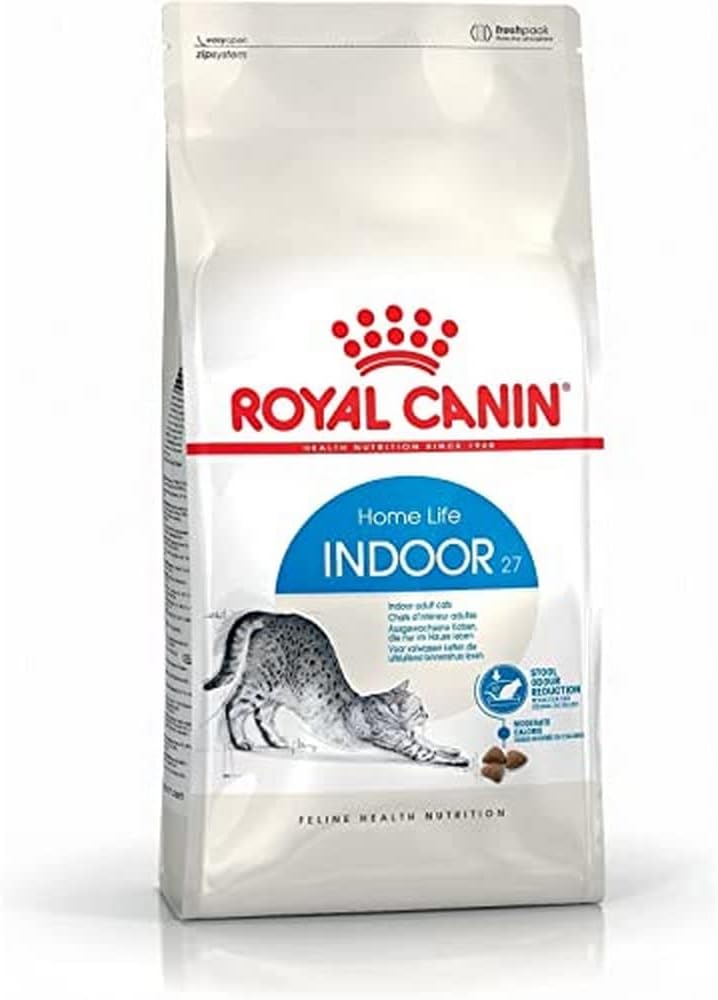Royal Canin Cat Food Indoor 27 400 g
- Brand: Unbranded

Description
This wet food is available in two different textures, to ensure even the fussiest of cats are satisfied. Enriched with targeted nutrients, such as: green tea polyphenols, vitamin C, EPA and DHA, helping to support your cat as it faces the first signs of ageing Avoid human food. They are not designed to meet your cat’s nutritional needs, as well as containing too many calories. Thanks to an added phosphorus level, Royal Canin Indoor 7+ also supports renal health by helping to maintain proper kidney function for your cat. Royal Canin Indoor 7+ Senior Dry Cat Food is specially formulated with all the nutritional needs of your senior indoor cat in mind.
Protein with high digestibility helps to reduce not only the quantity of your cat’s stools, but the odour as well Royal Canin Indoor Long Hair Dry Cat Food is designed for all adult long-haired indoor cats aged 1-7 years. Exact weighing of daily servings. Work out your cat’s daily needs and measure out the exact amount. Thanks to the inclusion of specific dietary fibres, such as psyllium, this food also helps to stimulate the clearance of ingested hair – resulting in a significantly reduced amount of hairballs. What’s more, ROYAL CANIN® Indoor 27 food also contributes to the health and maintenance of your adult cat’s urinary system. Variations of ROYAL CANIN® Indoor dry food are also available depending on your cat’s lifestyle, appearance, and age: Indoor Appetite Control, Indoor Long Hair, and Indoor 7+. Royal Canin Indoor 27 Adult Dry Cat Food is specially formulated with the nutritional needs of your adult indoor cat in mind.Royal Canin Indoor 27 Catalso contains special nutritious fibres such as psyllium, which help to regulate the digestive systemto ensure that swallowed hairs can move easily through the system, rather than causing your cat to vomit. Together with a moderate fat content, this contributes to your indoor cat maintaining an ideal bodyweight and thus being able to live a healthy life.
Vitamin A (13,500 IU), vitamin D3 (700 IU), E1 [iron] (42mg), E2 [iodine] (4.2mg), E4 [copper] (13mg), E5 [manganese] (55mg), E6 [zinc] (164mg), E8 [selenium] (0.09mg). dehydrated poultry protein, rice, wheat, maize, vegetable protein isolate*, animal fats, hydrolysed animal proteins, wheat flour, vegetable fibres, beet pulp, yeasts and parts thereof, soya oil, minerals, fructo-oligo-saccharides, fish oil, psyllium husks and seeds (0,5%). Crude ash: 7.3%. Crude fibre: 4%. Crude oil fats: 13%. Moisture: %. Protein: 27%. Indoor adult cats like yours tend to get less exercise than outdoor cats, that’s why a balanced and complete diet containing beneficial nutrients is important for optimal health.
Poultry protein (dried), rice, wheat, maize, vegetable protein isolate*, animal fat, animal protein (hydrolysed), wheat flour, lignocellulose, dried beet pulp, yeast and its derivatives, soya oil, minerals, fructo-oligosaccharides, fish oil, psyllium (seeds and husks: 0.5%). Indoor, adult cats like yours require a complete and balanced diet to ensure optimal health as they start to face the first signs of ageing. Complete wet food for adult sterilised indoor cats over the age of 1 year, with tender chunks in a delicious gravy, helping to support urinary health and ideal weight maintenance. The special recipe of this Royal Canin Indoor Sterilised 7+ in Gravy has been developd to help support weight maintenance in sterilised indoor cats.
- Fruugo ID: 258392218-563234582
- EAN: 764486781913
-
Sold by: Fruugo
